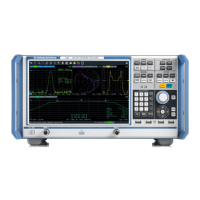GUI Reference
R&S
®
ZNB/ZNBT
319User Manual 1173.9163.02 ─ 53
6.5.7.1 Controls on the Distance to Fault Tab
The "Distance to Fault" tab provides controls that allow to enable and configure a stan-
dard Distance to Fault (DtF) measurement.
A standard DtF measurement is prepared in the order from top to bottom:
1. Enable DtF measurement, see "Distance to Fault" on page 319
2. Configure the distance window, see "Start Distance / Stop Distance" on page 320
3. Adjust the number of sweep points (and, if necessary, the frequency span), see
Auto Number of Points
4. Select (or define and select) a suitable cable type, see"Cable Type..." on page 321
5. Perform a full one-port calibration at physical port 2, see "Start Cal Unit... (P2) Refl
OSM / Start Cal... (P2) Refl OSM" on page 322
You should now be able to locate the faults (peaks) by examining the trace.
Or let the firmware generate a list of faults by enabling Fault Limit Check and defin-
ing a suitable Fault Limit. Use Fault List... to display (and export) the detected
faults.
Distance to Fault
Enables/disables Distance to Fault representation for the active trace.
Note that "Distance to Fault" can only be enabled, if the active channel is configured to
perform a linear frequency sweep (see "Lin Freq" on page 397).
The analyzer firmware assumes that the reflections of a DUT connected to port 2 shall
be measured. Hence it
●
replaces the measured value by S
22
Trace Config Softtool

